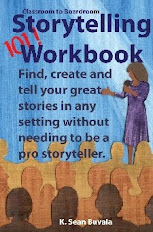I have been intrigued by some online conversations lately about the past and future of corporate storytelling. I will be writing a few more posts about this subject. Here's my first post.
The future of storytelling for business and nonprofit work is in its past. The foundation of storytelling has not changed. The need for storytelling has not changed. There is a reason that "how to tell a story" is a major Google search term.
Let's define some terms. "Story" exists in many forms. Beginning, middle and end all create a narrative "thing" that can be expressed through a variety of mediums such as dance, written word, digital audio and video and then, yes, storytelling.
"Storytelling" is another term we keep tossing about these days. To tell a story you need at least two people together at the same time: the teller and a listener. Without the storyteller in the room with the audience, you do not have storytelling. You have another expression of story. Without an audience in the same place as the storyteller, you may also have another expression of story, but it's not storytelling.
How you express story is your choice. As a storyteller, I have also used story in video, podcasts, on the page and in audio recordings. Those are not storytelling. Only when I can be with my audience, when I can see and hear them breathing, laughing and responding am I storytelling. Storytelling techniques are not digital techniques.
So, the past of storytelling was/is in the hearts and souls of millions of listeners. These millions of listeners heard the story proclaimed, saw the storyteller as real and human and participated in the creation of the storytelling event.
In that past, storytelling took one more leap into the next breath of the future. 2000 years ago, 200 years ago, 20 minutes ago, story moved forward in storytelling.
So now, we're abuzz with the buzz of "storytelling" for business and nonprofit use. After 25 years of doing this, I have seen the groundswell rise until we have a cacophony of experts, guides, coaches, conferences and strategists all ready to speak about story. Business owners are desperate to know what is the newest and latest technique to bring storytelling to their clients.
Look to the past. Storytelling is a relationship and conversation. It is an agreement between at least two parties to delve deep into the way "what if" became "what was" leading to "what will be." To business and nonprofit leaders, I ask you: what is your face-to-face relationship with your clients and customers? Are you still "we" to their "them?" Can any of your customers put a name to the storyteller they've met in your company?
Are you filling the conversation with noise? Is there a chance for your clients to meet a real person or are they forced to run only through your gauntlet of the social media cocktail-party and look-at-me loud videos?Are they lost in your forest of customer service? Where in your plan is the person-to-person live interaction? The future of storytelling is its past: converse with your customers. Tell and be heard. Hear and be informed.
In the past, storytelling taught the values of the community. Storytelling gathered the tribe to hear and feel the history of the group. Storytelling laid the groundwork for new innovation not because of the sophistication of the story but rather the listeners' ability (need?) to touch and interact with the mind of another live, in-the-moment storyteller. A story is an expression of "this was." Storytelling opens the door to "this could be."
If you want to move forward with storytelling for your business, you need to embrace this basic human need: "I need to talk with someone." The future of storytelling for your organization lies in its past: human interaction trumps noise. Stop being noisy and move to interaction.
I think we need to keep at the many ways to express story as I listed up at the top of this article. But don't call them storytelling. Rather, teach every member of your company the stories of your group. Teach them how to bring forth the stories of your collective past and to catch the stories as they continue to happen. Teach them to speak those stories to each other and clients.
The future of business storytelling is in its past and foundation:
people to people,
voice to voice,
face to face.
******
The official blog for K. Sean Buvala, storyteller and storytelling coach. Photo courtesy of http://www.fotolia.com/ .
Subscribe to:
Post Comments (Atom)






No comments:
Post a Comment